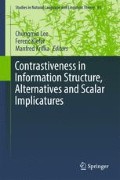Abstract
It has been assumed that the interpretation of a numeral n is determined as part of a scalar implicature, but there is a lot of evidence against it. First, numerals do not form a semantic scale but a pragmatic scale. Second, sometimes a numeral n is interpreted as ‘at least n’ or ‘at most n’, but the meaning of at least/most is not part of the meaning of a numeral. The meaning of a numeral is determined contextually. The basic principle is that we should make a statement as informative as possible. In making a statement informative, we consider two scales: one is the basic scalarity of largeness between numerals and the scalarity of likelihood. The two scales apply to two different regions with respect to a quantifier. The informativeness from the basic scalarity requires the numeral mentioned to be the maximal number of elements involved when each member in the quantifier domain is considered. And the alternative sentences with the numeral replaced with an alternative numeral are ordered by the informativeness from the unlikelihood scalarity, making the number mentioned a limit value among the maximal numbers of the elements involved in the meaning of the quantifier. The limit number n is taken to be ‘at least n’ or ‘at most n’. If no overt quantifier is involved, a universal quantifier over epistemic alternatives is provided by the support conditions of the sentence.
Access this chapter
Tax calculation will be finalised at checkout
Purchases are for personal use only
References
Atlas, Jay D. 1992. Why ‘three’ does not mean 3: Scalar implicatures, truth-conditions, and meaning. Manuscript, Pamona.
Breheny, Richard. 2008. A new look at the semantics and pragmatics of numerically quantified noun phrases. Journal of Semantics 25: 93–139.
Carston, R. 1998. Informativeness, relevance, and scalar implicature. In Relevance theory: Applications and implications, ed. R. Carston, and S. Uchida, 179–236. Amsterdam: John Benjamins Publishing Co.
Geurts, Bart. 2006. Take “five”: The meaning and use of a number word. In Non-definiteness and plurality, ed. S. Vogeleer, and L. Tasmowski, 311–329. Amsterdam/Philadelphia: Benjamins.
Grice, Paul. 1975. Logic and conversation. In Syntax and semantics 3: speech acts, ed. P. Cole, and J. Morgan, 41–58. New York: Academic Press.
Horn, Larry R. 1984. Toward a new taxonomy for pragmatic inference: Q-based and r-based implicature. In Meaning, form, and use in context: Linguistic applications, ed. D. Schiffrin, 11–42. Washington, DC: Georgetown University Press.
Horn, Larry R. 1992. Pragmatics, implicature, and presupposition. In International encyclopedia of linguistics, ed. W. Bright, 260–266. Oxford: Oxford University Press.
Horn, Larry R. 1996. Presupposition and implicature. In The handbook of contemporary semantic theory, ed. S. Lappin, 299–319. Oxford: Blackwell Publishers.
Koenig, Jean-Pierre. 1991. Scalar predicates and negation: punctual semantics and interval interpretations. In Chicago linguistic society 27, part 2: Parasession on negation, pp 140–155.
Krifka, Manfred. 1999. At least some determiners aren’t determiners. In The semantics/pragmatics interface from different points of view, ed. K. Turner, 257–291. Oxford: Elsevier.
Levinson, Stephen C. 1987. Minimization and conversational inference. In The pragmatic perspective, ed. J. Verschueren, and M. Bertuccelli-Papi, 61–127. Amsterdam: Benjamins.
Partee, Barbara. 1986. Noun-phrase interpretation and type-shifting principles. In Studies in discourse representation theory and the theory of generalized quantifiers, eds. Studies in Discourse Representation Theory and the Theory of Generalized Quantifiers. Dordrecht: Reidel, pp 115–144.
Recanati, François. 1989. The pragmatics of what is said. Mind and Language 4: 295–329.
Sadock, Jerrold. 1984. Whither radical pragmatics? In Meaning, form and use in context: Linguistic applications, ed. D. Schiffrin. Washington: Georgetown University Roundtable, Georgetown University Press.
van Kuppevelt, Jan. 1996a. In defense of semantics: Scalar inferences as topic-dependent entailments. In AAAI spring symposium on computational implicature: Computational approaches to interpreting and generating conversational implicature, ed. et al BDE, Stanford University Press.
van Kuppevelt, Jan. 1996b. Inferring from topics: Scalar implicatures as topic-dependent inferences. Linguistics and Philosophy 19(4): 393–443.
Author information
Authors and Affiliations
Corresponding author
Editor information
Editors and Affiliations
Rights and permissions
Copyright information
© 2017 Springer International Publishing Switzerland
About this chapter
Cite this chapter
Yeom, JI. (2017). Interpretations of Numerals and Structured Contexts. In: Lee, C., Kiefer, F., Krifka, M. (eds) Contrastiveness in Information Structure, Alternatives and Scalar Implicatures. Studies in Natural Language and Linguistic Theory, vol 91. Springer, Cham. https://doi.org/10.1007/978-3-319-10106-4_15
Download citation
DOI: https://doi.org/10.1007/978-3-319-10106-4_15
Published:
Publisher Name: Springer, Cham
Print ISBN: 978-3-319-10105-7
Online ISBN: 978-3-319-10106-4
eBook Packages: Social SciencesSocial Sciences (R0)

